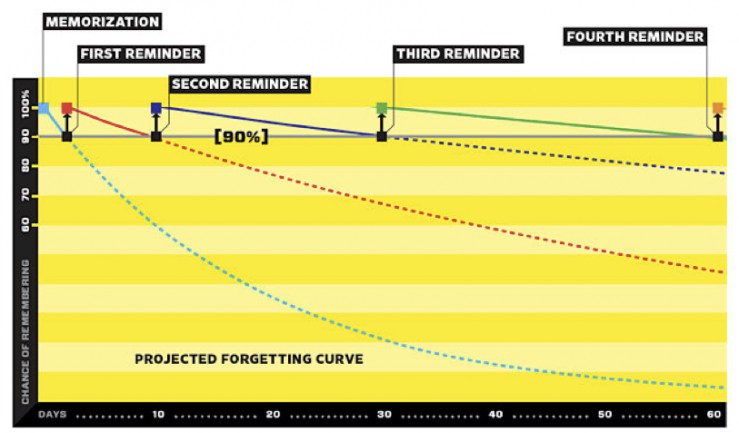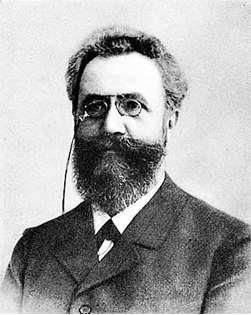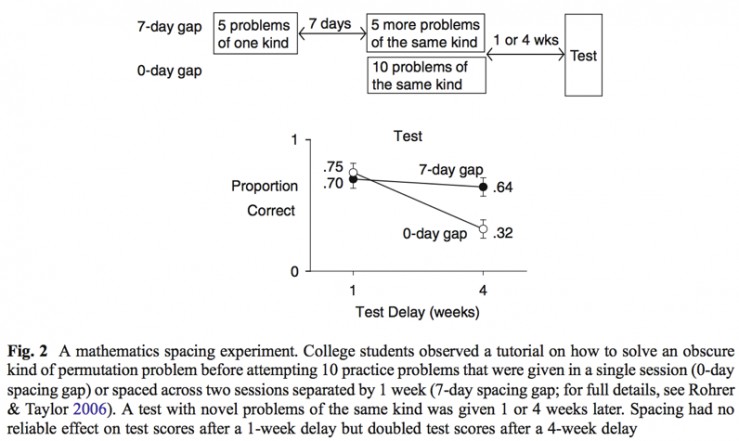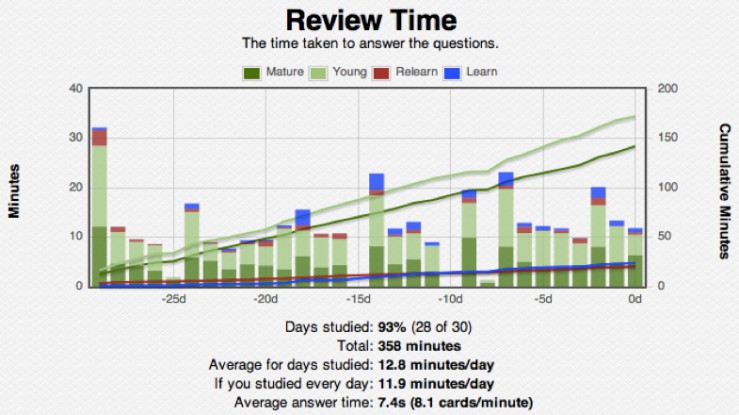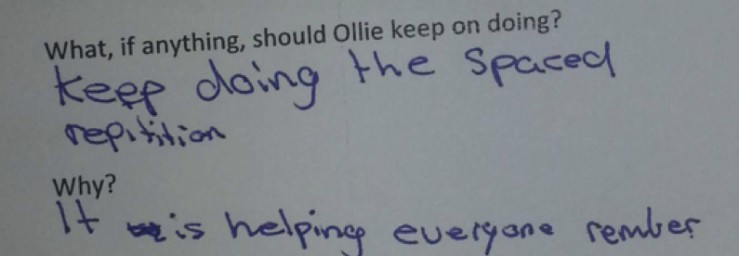This post is one of a series detailing my current mathematics lesson rhythm and routine. This one outlines how I use spaced repetition software (SRS) at the start of my lessons to help students to remember key information. There is a video of me teaching with SRS at the bottom of this post.
Thinking back to my own time at school, I distinctly remember one challenge in particular. I remember feeling that studying mathematics in discrete topics (or units), made it really hard for me to remember the relevant concepts when it was time to revisit that branch of mathematics again, sometimes over a year later.
Through my post-schooling forays into language learning in particular, I have come across some research backing up those schoolboy intuitions.
What I was feeling was the effects of a cognitive phenomena called the ‘forgetting curve’ (Ebbinghaus, 1913). The forgetting curve (pictured below) is a graph that approximates the rate at which an individual will forget a given unit of information.
(image source: https://www.flickr.com/photos/suzymushu/3411344554)
In the late 1800s, a German chap by the name of Hermann Ebbinghaus constructed the first forgetting curve by trying to memorise nonsense syllables (such as “WID” and “ZOF”) and then testing himself at regular intervals, rating his level of accuracy, then plotting these points out on a graph.
(Old mate Ebbinghaus: https://commons.wikimedia.org/wiki/File:Ebbinghaus2.jpg)
As can be seen in the picture of the forgetting curve, if we want to remember something, we need to be reminded about it at regular intervals*. The good news is that the more times we’re reminded about it, the longer the interval until we need to be reminded about it again!
*(The necessity of reviewing a unit of information at regular intervals is obviously dependent on what the unit of info is, and how it relates to your prior knowledge/how emotionally charged that memory is. For example, It’s highly unlikely you’ll ever forget your first kiss! Ebbinghaus’ original forgetting curve is, however, a great approximation for units of info like; words in a foreign language, or even terms such as ‘perimeter’ or ‘circumference’.)
Such a curve has important implications for teaching and learning. If we want a student to remember the basics of trigonometry when we come around to the topic again a year later (e.g., basic terminology, sum of the angles in a triangle, etc), we had better ensure that several times between now (time of teaching) and next year, they get reminders at key intervals.
The basic idea underlying this reminding-at-intervals is the spacing of repetition. We all know that it isn’t a good idea to cram your study, but a recent meta-analysis of studies, Carpenter, Cepeda, Rohrer, Kang and Paschler (2012) brought together research on the actual effectiveness of spacing repetition. The following excerpt details the results from just one of the studies that they cited in their meta-analysis.
(Carpenter et al., 2012, p. 371)
This is all well and good as a concept, but how can we do it in practice? There are literally hundreds of new words and concepts that a student is expected to grasp in a year, is it realistic for a teacher to keep track of each of these terms and ideas, and remind students of all of them at periodic intervals?
I’m hoping that the answer is yes.
In 2014 I set myself the challenge to learn Mandarin Chinese in a year. As I delved deeper and deeper into effective learning methods, I came across spaced repetition software (SRS). SRS is a program of digital flash cards (you can make them yourself, or download pre-made decks) that, based on self-ratings, uses an algorithm to calculate the optimum time to review each given unit of information. It is essentially plotting your forgetting curve and reminding you of that piece of information just before you forget!
This software has been notably used to great success by such polyglots as Scott Young (who learnt 4 languages to a very high standard in one year) and Benny Lewis (very famous polyglot). It definitely helped me, and with the help of the SRS program that I use, Anki, I was able to reach my goal and achieve a conversational level of Mandarin within a year. These days I use it to remember a whole host of things; from people’s names, to new english words, to the countries of the world. I currently have a little over 3000 digital flash cards in my review ‘circulation’ and to keep on top of all this info it only takes between 10 to 15 minutes of my time per day. Here’s a snapshot of my study statistics from the last month.
(my personal spaced repetition data from the past month)
I was really keen to bring this incredibly powerful tool into the classroom to try to help my students to overcome the memory challenges that I, myself, faced as a student. So I did!
Since I started teaching at the start of this year, I’ve been using an SRS program (Anki) in all of my classes. We use it at the start of every lesson and I call students’ names with the use of coloured pop-sticks, a method that I’ve written about previously.
The result?
It’s hard to comment on the long term effects as it’s still early days, but student feedback has been good, for example: On the end of Term 1 feedback form that I handed out to students, many of them made comments such as the following:
But hey, I thought that the most helpful thing would be to give readers some eyes into my classroom to see exactly how it plays out. With my students’ permission, I’m sharing below a clip from my VCAL (Victorian Certificate of Applied Learning) numeracy class. Just for a bit of context, VCAL is a program designed for students who are planning to explore post-secondary pathways into vocational training. I have students who want to be nurses, flight attendants, and many of them aspire to the a position in the military. What you see below is a classic beginning of lesson episode. One of the students (Sharnee) is in charge of the pop-sticks, pulling out student names, and the other students are sitting (with varying degrees of focus), considering what their answer would be, then answering if their name is called up. I’ve found that the students enjoy the routine and it adds a game show like feel to the start of the class. Hopefully this little clip gives you a bit of a glimpse into how Anki works, and how I feel it can help my students to overcome one of the challenges that I myself faced in school.
References:
Carpenter, S. K., Cepeda, N. J., Rohrer, D., Kang, S. H. K., & Pashler, H. (2012). Using Spacing to Enhance Diverse Forms of Learning: Review of Recent Research and Implications for Instruction. Educational Psychology Review, 24(3), 369–378. http://doi.org/10.1007/s10648-012-9205-z
Ebbinghaus, H. (1913). Memory: A contribution to experimental psychology, (3).
